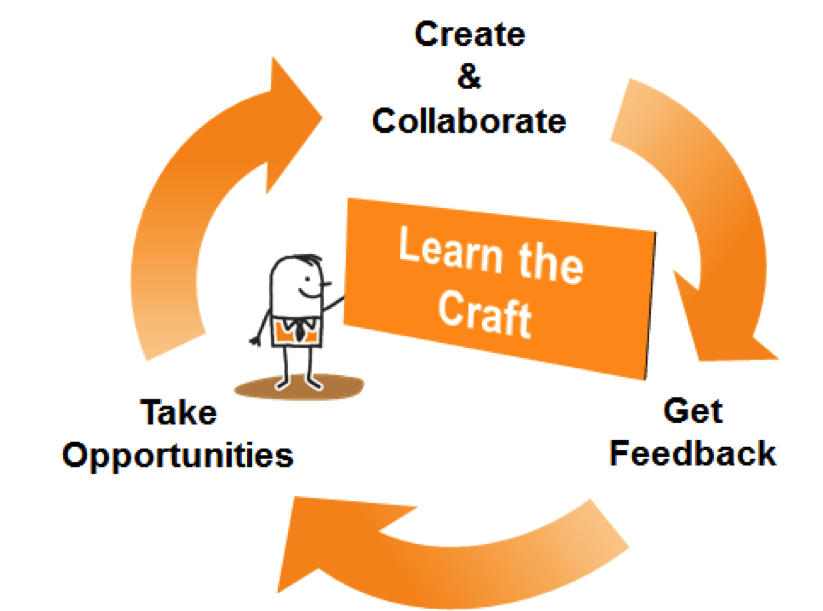Learning the craft
“Some people will tell you that great writing cannot be learnt. Such people should be repeatedly hit on the nose until they promise not to talk nonsense anymore.”
Mark Forsyth
 Comedy is scary, because there is an indisputable result at the end. Either someone laughs or they don’t.
Comedy is scary, because there is an indisputable result at the end. Either someone laughs or they don’t.
But comedy is also just like everything else. The more you do it, the better you get. No one is brilliant straight away. Seriously no one. But if we enjoy doing it, we can get there through learning and practising the craft.
We’ve written an article about exactly this if you want to read more – Am I Funny Enough To Make Comedy?
This second part of the course tells you exactly what you need to do to start your journey as a comedy creator, linking you to the best advice we have come across after years of research.
There’s a lot here but remember, you don’t need to know all the rules straight away. The important thing is to practise the craft, whether that’s writing, filming or performing. The tips here focus on writing, because writing is required in any comedy format so we think it’s a pretty good place to start.
We have split the links into a 3 stage roadmap for new comedy writers:
- What is comedy and why do people laugh
- Developing your characters
- Putting your characters into sketches and sitcom
Once you’ve read through some of these articles you will be primed and ready to unleash your creativity. That’s great! Go with it and see what you come up with. We’ll talk more about how to create through collaboration in the third part of this series.
But for now, let’s get into the good stuff:
1. What is comedy and why do people laugh?
If you are starting out in comedy then it’s worth taking a step back and considering what makes something funny. We don’t want to get too abstract, but knowing the psychology behind comedy is important because it shows just how many options you have for creating humour. Yes comedy is subjective, but there are common themes to use as a starting point.
- What is comedy and what makes something funny by Thinctanc.co.uk provides an overview of the different types of comedy, and how you can use each one
Here’s a good exercise. List the different comedy types from the thinctanc article and consider which ones you enjoy, which make you laugh. Now consider how they have been applied in some of your favourite comedies, and how they can be used together. For example, ironic situations often befall farcical comic characters to help escalate their fundamental flaws, such as in the Monty Python sketches.
Its also very helpful to know a bit about the psychology of comedy. After all, you are going to try to make people laugh, so it’s good to know why we do. Start by thinking about why you laugh in certain situations. Do you always laugh when you find something funny? Do you laugh less when you’re alone rather than in a group of people guffawing their collective heads off?
The key principle behind why we laugh is surprise. The laughter is our positive reaction to understanding the surprise and realising we are not vulnerable to the situation, rather than our fearful response to a dangerous or confusing surprise. Take a look at the following 2 articles for more information:
- Why do we laugh by Tim Ferguson focusses on the psychology behind laughter and what it is about a joke that creates such a reaction
- 2 fundamentals of comedy writing by Comedy Crowd member Daniel Page builds on the fight or flight arguments made by Tim Ferguson, and focusses on the use of surprise and context in making something funny
Now think about how this applies to the sort of comedy you might want to create. What is your style, what existing techniques could you use, and how could you use the theory about what causes audiences to laugh to find original ways to make your comedy work? And most importantly, how can these principles be applied to your characters?
2. Developing characters
Characters are the heart and sole of situation comedy, the reason we watch, get hooked and laugh.
We have to build strong characters, but also find the right situational and relationship dynamics to make them funny. Start off by creating your main character/s, and go deep. Really deep. Think about some key questions like who they are, what they want and, importantly for comedy, why they can’t get it!
Who they are doesn’t just mean name and age. It means name, age, education, finances, skills, interests, relationships.
What they want means what are their hopes and dreams. What one thing would make them happy and make their life a success?
And why they can’t get it means flaws. The essential comedy traits. What is it about them that prevents them from achieving what they want? What stresses, pressures and personality traits are holding them back?
Here are some exercises that will help you answer these questions:
- Taking your characters out for a coffee from Blondwritemore.com is a fun one to start with. The author recommends sitting opposite your character in a coffee shop and visualising what they look like, smell like, and what they order.
Taking them out of their regular context is a great way to focus on how they should react in any situation.
This is a key point: comedy characters don’t have to be realistic, but they must be believable.
Your character can take any unrealistic physical form, as long as it’s response to situations remains consistent so that the audience build an expectation and find its actions believable based on that expectation. Otherwise they won’t laugh. And that’s quite important. A talking dog and baby in Family Guy is certainly not realistic, but their characteristics are absolutely honed and consistent throughout the show.
- This character pyramid from writershelpingwriters.net is a great tool for helping you focus down on the key flaws your character presents, and how that impacts their behaviour in different situations
- The best advice I ever received by script editor Andrew Ellard gives another way to visualise your characters by getting them to write each other’s profiles. This is great because it helps you learn about both characters at the same time.
Andrew Ellard’s article then goes further to talk about character traits being enhanced through “difference” between characters. This is the next step. Once your character is defined, we need to look at the situations and relationships that make them funny.
- Setting up a funny relationship by Chris Head is a good short article on how to think about relationships in your character’s life to introduce humour
- Why audiences laugh by Mike Corke is an excellent read and a more in depth look at the character interactions and situations that result in the most successful comedies
Only once your character and situation are in place should you start thinking about how to structure your comedy.
3. Writing sketches and sitcom
All the advice we have come across from research, and from looking into the backgrounds of successful comedians, suggests that the best place for creators to start is in sketches.
Why? Because it forces you to keep the comedy writing tight, make the laughs frequent, and not focus too much on anything else. Sketches are short, simple, and achievable. They give you the chance to make real comedy from scratch.
It’s important to know a few basics of good sketch comedy before starting. The most fundamental one is to get the comedy in quickly because sketches are short by their nature, so you don’t have time to add non-essential content.
In terms of structure, there are a few variations on what makes a sketch a sketch, but here are the common elements:
- Set up the characters, location, and conflict
- Escalate the conflict
- Bring it to a resolution
- Structuring a sketch by Sketchwright.com expands on this principle, introducing examples from Mitchell and Webb to look deeper into how a sketch is constructed
- Writing sketches for a living by Dave Cohen goes into further detail on sketch structure and the features of a good sketch
And if you want to try your hand at writing comedy sketch songs or poems:
- Writing comedy songs is from the Treason Show website. Their competition is closed now but the tips on writing comedy songs are very much still valid.
Before you start going further and working on a sitcom or film script we recommend playing around with the character in short form first. Writing sketches, monologues, filming them if you can will help you learn what works and what doesn’t from a comedy perspective quickly before worrying about structure. And the comedy really is the most important skill to master.
If you’re ready to tackle a sitcom or longer form piece, look at this great article which runs you through the key steps for how to craft your plot:
- Sitcom structure: 6 tips for writers from Bang2write.com uses The Simpsons as an example to show the different plots and stories that move a situation comedy forward. You will notice the same 3 part structure as discussed above for sketches, but the need for subplots to move the story forward makes longer form writing more complex.
So that’s an overview of the basics you should know for writing comedy. Keep enjoying the journey fellow creators, and we’ll see you in stage 3 where we explore how to create through effective collaboration.
Click here to read stage 3: Create & Collaborate

